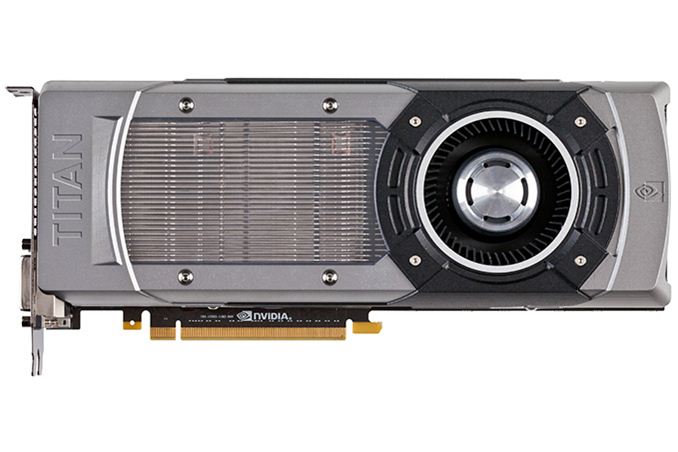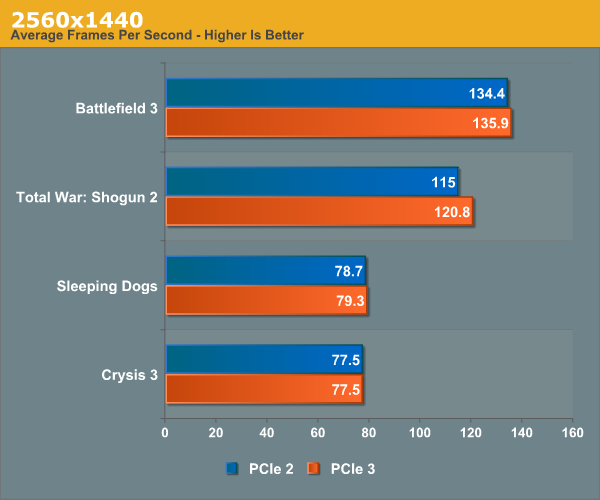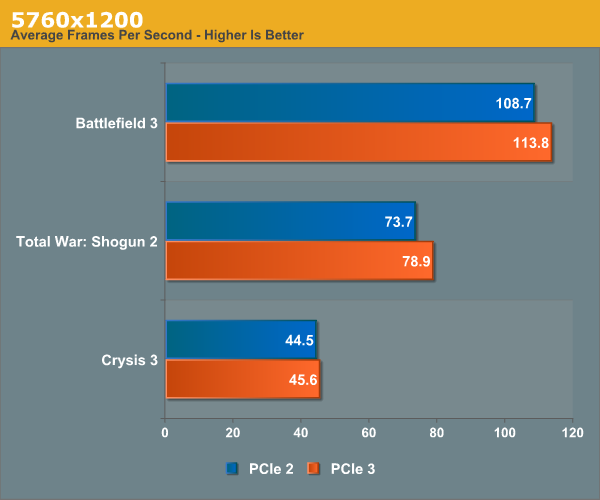GeForce GTX Titan Two-Way SLI Scaling: PCIe 2 vs. PCIe 3
by Ryan Smith on June 21, 2013 9:00 AM EST
Back when I had Origin’s tri-Titan equipped Genesis in house, I received a few requests for benchmarks with PCIe 3 enabled. Because we tested the system with its default out of the box settings, the system was configured by default to only use PCIe 2 since NVIDIA does not officially support PCIe 3 on SNB-E based systems. As a result there was some interest in whether PCIe 3 would improve performance at all compared to PCIe 2, due to the high amount of PCIe bus traffic generated by three GTX Titan cards working together. IVB/Haswell is of course limited to 16 PCIe 3 lanes, whereas if PCIe 3 is enabled SNB-E systems have more than twice that with a combined total of 40 lanes, giving SNB-E a large bandwidth advantage.
As it turned out, the Intel DX79SR used in the Genesis supported PCIe 3, but only on the 2 full-fledged x16 slots. The third x16 slot (electrically x8) won’t operate beyond PCIe 2 speeds even after forcing it in NVIDIA’s drivers, which is unfortunately a bit of a double whammy since it’s the slot that’s already lacking in bandwidth. That dashed our hopes of a PCIe 3 vs. PCIe 2 comparison for tri-SLI Titans, and as a result the subject never reached print.
However in the last couple of weeks I’ve received several requests for two-way SLI Titan/780 PCIe performance benchmarks, which we did happen to collect while looking into tri-SLI and merely never published. So with that in mind we’re going to finally publish that data, since there’s clearly more interest in the matter than I initially expected.
As a heads up this data is a bit stale; it was taken back in April with NVIDIA’s 314.22 drivers. So the primary goal here is to compare two-way SLI Titan performance on PCIe 2 versus PCIe 3.

At 2560x1440 there’s very little change. The only game to see any kind of notable improvement is Total War: Shogun 2, which picks up 5%, though this is going from 115fps to 120fps. Otherwise PCIe 3 does not confer a distinct performance advantage here.

At 5760 things become more interesting, although again the performance gains aren’t particularly huge. Every game benefits at least marginally from PCIe 3 being enabled; Total War: Shogun 2 once again shows the greatest benefit at 7%, while Battlefield 3 picks up 5%, and Crysis 3 a hair over 2%.
Admittedly this is a small sample set, but it does paint a distinct picture of the PCIe bus being a bottleneck when using surround modes. NVIDIA has never gone into great detail on how their surround mode works, but based on this and previous data we’ve long assumed that they’re shuffling a significant amount of data around via the PCIe bus in order to keep the cards in sync and to give each card the portion of the frame buffer it will be responsible for sending to its attached display(s). This is as opposed to 2560x1440 and other single monitor modes, where the master card merely needs to collect completed frames and there’s no further redistribution involved.
In any case, while NVIDIA does not officially support PCIe 3 on SNB-E systems, between the Genesis and our own testbed we’ve yet to run into an issue in using it. Consequently we can’t see any good reason not to enable it, especially in surround mode setups. Based on our data the performance gains aren’t going to be huge (at least not in two-way SLI), but it’s free performance being left on the table. At the very least it’s worth a shot, since NVIDIA makes it easy to turn PCIe 3 support on and off.










21 Comments
View All Comments
JMC2000 - Friday, June 21, 2013 - link
That is interesting. Ryan, do you think that a triple 30" setup could show even a larger difference?dishayu - Friday, June 21, 2013 - link
So, what this essentially means is that one can use a PCIe 3 x8 slot for any current GPU without worrying about bandwidth constraints, since offers the same bandwidth as a PCIe 2 x16 slot.Granseth - Friday, June 21, 2013 - link
I would be interested in knowing if PCIe 2 or 3 affects frame times and min fps as well.fokka - Sunday, June 23, 2013 - link
i don't think so, if it's not even influencing fps in a significant way.tipoo - Friday, June 21, 2013 - link
I'll be curious to see Thunderbolt 2 scaling, since even though there's not much difference between PCI E 2 and 3 here the difference between PCI and Thunderbolt is still huge.sna1970 - Saturday, June 22, 2013 - link
Thunderbolt 2 is around 3-4 PCIe 3.0 lanesMartinT - Saturday, June 22, 2013 - link
Nope, Thunderbolt 2 is still 4 lanes of PCIe 2.0, the only difference between v1 and v2 of Thunderbolt is that v2 allows for channel-bonding at the logical level, so you can use those same 4 lanes to connect to a single device, when w/ v1 you were limited to 2 lanes (single channel) per device.SantaAna12 - Friday, June 21, 2013 - link
Thank you. Disappointing, but good to know.chizow - Friday, June 21, 2013 - link
I'm not sure how useful the AVGs are in this case Ryan. Don't you think it would be more informative to give some type of FPS vs. time graph, to show the peaks and valleys in framerate? Or even some type of percentile measurement, giving how much time is spent above certain framerate thresholds. I think I'd be more interested to see if PCIe 2 v 3 results in a significant difference in minimum FPS mainly, because slight dips are going to get lost in a sea of frametimes in an average, but will be very noticeable IRL.DanNeely - Friday, June 21, 2013 - link
In other recent gfx threads Anandtech editors have said that accumulating and processing time per frame data is too time consuming to make it into their current review/benchmarking workflows.Unfortunately, until the toolchain improves that sort of data appears likely to remain the province of more specialized review sites.